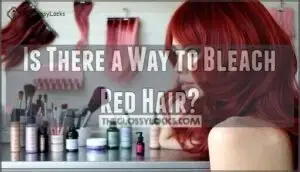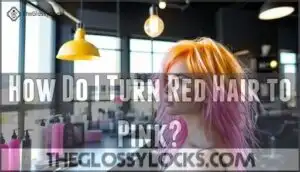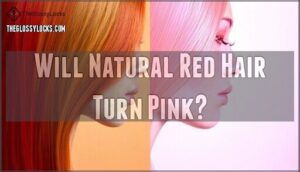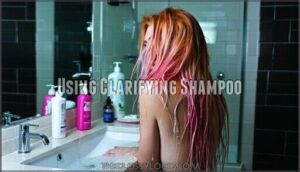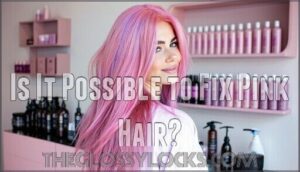This site is supported by our readers. We may earn a commission, at no cost to you, if you purchase through links.
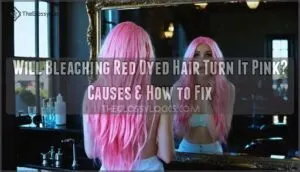
Here’s the brutal truth: bleaching red-dyed hair absolutely can turn it pink, and it happens more often than you’d think. Red pigment molecules don’t just fade gracefully when bleach attacks them—they fracture into smaller, stubbornly pink fragments that cling to damaged hair like they’re paying rent.
Your hair’s porosity, the bleach strength you chose, and how long that red has been sitting in your strands all conspire to determine whether you’ll end up with the clean slate you wanted or an unexpected pink predicament.
The good news? Pink hair isn’t a life sentence, and understanding why it happened gives you the power to fix it—or better yet, avoid it next time you’re ready to ditch that red for good.
Table Of Contents
- Key Takeaways
- Can I Use Hair Color Remover?
- Is There a Way to Bleach Red Hair?
- How Do I Turn Red Hair to Pink?
- Why Did My Hair Turn Pink After Bleaching?
- Will Natural Red Hair Turn Pink?
- Using Clarifying Shampoo
- Is It Possible to Fix Pink Hair?
- Frequently Asked Questions (FAQs)
- Can You dye red hair pink?
- Does bleached hair turn pink?
- Can I dye my hair red without bleach?
- Can You dye pale blonde hair red?
- Why does my brown hair turn yellow after bleaching?
- Will bleach turn my hair pink after clarifying shampoo?
- How long should I leave bleach on my hair to turn it pink?
- Is it safe to use clarifying shampoo regularly?
- How can I avoid overcorrecting my hair to green?
- How long does pink tone last after bleaching?
- Conclusion
Key Takeaways
- Bleaching red-dyed hair turns it pink because red pigment molecules break down into smaller pink fragments that stubbornly cling to damaged, porous strands instead of lifting completely.
- Natural red hair never turns pink when bleached since it contains pheomelanin that breaks down into brassy copper or yellow tones, not the synthetic pigments found in artificial dyes.
- You can fix unwanted pink tones through strategic toning with green-based neutralizers, clarifying shampoo to gradually fade the color, or carefully applied additional bleach sessions spaced out to prevent breakage.
- Hair porosity, bleach strength, developer volume, and how long the red dye has been sitting in your hair all determine whether you’ll end up with pink chaos or a clean slate for your next color.
Can I Use Hair Color Remover?
If you’ve ever stared at your reflection wondering whether a color remover could save you from an unwanted pink disaster, the short answer is yes—but you’ll want to know the full story before you take the plunge.
Color removal strips artificial pigment without the harshness of bleach, making it a solid bleach alternative when you’re dealing with stubborn red tones. That said, it won’t work miracles if your hair’s been layered with dye for months.
After using a remover, wait at least two weeks before any bleach or toner applications—your strands need recovery time to avoid serious hair damage. Think of it as gentle correction, not an instant fix.
Is There a Way to Bleach Red Hair?
Bleaching red-dyed hair isn’t off the table, but you need to know what you’re getting into before you commit to the process. Red pigments cling stubbornly to your strands, and bleach strength matters—go too weak and you’ll get pink, too strong and you’ll fry your hair.
Hair porosity plays a huge role in how bleach absorbs, so damaged locks lift unevenly. A bleach bath offers gentler color correction than straight bleach, diluting the formula to minimize damage while still lifting color. Expect multiple sessions and serious aftercare.
- Assess your hair’s condition first—brittle strands will break under aggressive bleaching red dyed hair treatments
- Choose the right developer volume—20-volume for moderate lifting, 30 if you’re brave and your hair’s healthy
- Consider strand testing—bleach a hidden section to preview your pink potential before full commitment
- Space out sessions—rushing hair bleaching techniques back-to-back guarantees breakage and uneven color change
- Prep for toning afterward—bleaching red hair rarely stops at one step; color correction finishes the job
How Do I Turn Red Hair to Pink?
Turning red hair pink on purpose takes the same bleaching firepower, but this time you’re steering into the skid instead of fighting it. You’re aiming for that yellow base where pink pigments thrive—just enough bleach application to lift red without obliterating your strands. Hair porosity dictates how evenly your color lifts, so strand test first. Once you hit pale yellow, pink toning or direct dye seals the deal. Skip fading techniques here; you want controlled color correction, not accidental outcomes.
- Clarify first—strip old buildup so bleach penetrates evenly across all strands
- Monitor your lift—stop bleaching red dyed hair at pale yellow, not white platinum
- Choose pink shade strategically—pastel needs lighter base than hot magenta tones
- Tone or dye directly—semi-permanent pink over yellow creates vibrant, dimensional results
- Condition relentlessly—bleach wrecks moisture balance; deep treatments prevent breakage and guarantee pink hair longevity
Why Did My Hair Turn Pink After Bleaching?
Your hair turned pink after bleaching because red dye molecules don’t vanish—they break down into smaller pink pigments that cling stubbornly to your strands. The bleaching process oxidizes those big red molecules, but it stalls halfway, leaving pink chromatophores embedded in your hair.
Higher porosity zones—think damaged ends—grab onto these pink tones harder, creating uneven hot-pink patches. If you rushed the bleach or used a weak developer, you didn’t give those pigments enough time or firepower to lift fully.
Hair damage amplifies this chaos, trapping color correction nightmares in brittle, porous sections that refuse to cooperate. Understanding the hair bleaching process is essential to avoiding such issues.
Will Natural Red Hair Turn Pink?
Why doesn’t natural red hair turn pink when bleached? Red hair genetics work differently than dyed hair—your natural pigment contains pheomelanin, not synthetic molecules. Bleaching natural red hair strips these pigments down to brassy, copper, or yellow tones because the breakdown of pheomelanin never produces pink.
Only artificial red dyes harbor residual pigments that morph into pink during bleaching red dyed hair. Hair porosity affects how evenly these warm tones lift, but you’ll never see pink from your natural melanin. That pink hair outcome? Strictly a hair color correction issue tied to dyed strands, not your genetic redhead blueprint.
Understanding the red hair genetics can help explain why natural red hair behaves differently than dyed hair when bleached.
Using Clarifying Shampoo
Clarifying shampoo won’t magically erase pink tones on its own, but it can help fade them gradually over time.
If you’re stuck with stubborn pink pigments after bleaching your red hair, there are two main ways to tackle it. Here’s how to get rid of that unwanted pink.
Use More Bleach
If stubborn pink still clings to your strands after clarifying shampoo, another round of bleach might be your ticket to that clean, yellow base you’re after. But here’s the thing—bleach timing and developer volume matter more than you think.
Higher developer volume lifts faster, but damaged hair or high porosity can turn the process unpredictable. Apply your bleach strategically, watch it like a hawk, and don’t push beyond what your hair can tolerate.
Bleaching red dyed hair takes patience, not aggression. Overdoing bleach strength without considering hair lightening limits? That’s how you trade pink for breakage.
Tone The Pink Out
Sometimes a well-placed toner does what a second bleach can’t—it neutralizes that pink without adding more damage to the equation. Purple shampoo or a pink neutralizer shifts hair pigmentation through the toning process, canceling out unwanted warmth.
Color correction and toning give you control over fixing pink hair after bleaching red dyed hair, no extra lifting required. Color correction beats destruction every time.
Is It Possible to Fix Pink Hair?
Yes, pink hair is absolutely fixable—and you don’t need to panic or book an emergency salon appointment just yet. Fixing pink hair after bleaching red hair safely is totally doable with the right color correction approach.
Grab a clarifying shampoo first—it’ll wash out product buildup that could be making those pink tones pop more than they should.
Next, take an honest look at your hair’s condition. If it’s already toast, skip another round of bleach and go straight to toner. Stubborn pink hanging on? A green-based toner works magic here since green sits opposite pink on the color wheel and cancels out that warmth.
Now, here’s the thing: lightening and toning work together. If your base color’s still too dark, you might need one more careful bleach session before the toner can do its job properly.
Color correction and toning with blue or purple shampoos can gradually fade pink tones over several washes. For a quicker fix, apply a professional toner like Wella Color Touch or use a demi-permanent dye in your target shade. And here’s the kicker—some people embrace pink hair dye options and rock the unexpected result. But if blonde’s your goal, patience and proper toning will get you there without wrecking your hair.
Frequently Asked Questions (FAQs)
Can You dye red hair pink?
You can absolutely dye red hair pink—it’s one of the most natural color transitions you’ll ever pull off.
Red and pink share warm pigments, so dyeing red hair pink without bleach is totally doable. Just grab a pink hair dye and apply it directly over your red shade.
Does bleached hair turn pink?
Bleach can reveal warm undertones lurking in previously colored hair, which often show up as unwanted pink shades.
This happens more often when hair is highly porous or when bleaching isn’t done carefully enough to manage the risks.
Pink tones emerge when color correction falls short, bleach isn’t applied evenly, or damage from bleaching disrupts the hair’s pigment structure.
Can I dye my hair red without bleach?
Think outside the bleach bottle—red hair alternatives exist.
You can dye your hair red without bleach using semi-permanent dyes, natural dyes like henna, or red tinting products that deposit color instead of lifting it.
Can You dye pale blonde hair red?
Pale blonde hair is a perfect canvas for red hair dye—no bleaching required.
Your hair porosity absorbs vibrant reds beautifully, giving you full color payoff without the harsh color correction process that darker shades demand.
Why does my brown hair turn yellow after bleaching?
Brown hair holds yellow undertones that bleach damage exposes—your hair porosity determines how evenly those tones lift.
Proper toner application after bleaching techniques neutralizes yellow, making color correction essential for anyone bleaching red dyed hair or shifting shades.
Will bleach turn my hair pink after clarifying shampoo?
If your hair still has warm or red pigments after clarifying shampoo, bleach can expose pink tones. Hair porosity and bleach strength determine how much color lifts.
Proper color correction techniques and pink toner application help fix unwanted hues.
How long should I leave bleach on my hair to turn it pink?
Timing is critical for bleach lifting red pigment into pink territory. Check your hair every 5 minutes—hair porosity and bleach strength dictate how fast color lifts.
Most reach pink toning between 10-15 minutes, but pulling the trigger early prevents damage and keeps you in control of the transformation.
Is it safe to use clarifying shampoo regularly?
Sure, daily clarifying shampoo strips your hair of everything—including the moisture and natural oils it actually needs.
Use it once a week, max, especially after bleaching or color treatments. Your hair will thank you for choosing gentle cleansing the rest of the time.
How can I avoid overcorrecting my hair to green?
Overcompensating with green neutralizer is the fast track to Shrek territory.
Start with clarifying shampoo to strip stubborn pigment, then apply toner sparingly—watching your hair porosity closely.
Test on a small section first, because bleach formulas react differently based on your hair’s damage level and previous color correction attempts.
How long does pink tone last after bleaching?
Without proper toner application, pink tones from bleached red hair usually persist for two to four weeks before naturally fading.
Your fading process accelerates with clarifying shampoos, though color correction techniques or additional bleach aftercare can neutralize stubborn pink hues faster.
Conclusion
Red pigment is notoriously stubborn—the more you fight it, the worse things get. Once you understand why bleach turns red-dyed hair pink, though, you can dodge that outcome entirely.
You’re not stuck with bubble-gum strands forever. Color removers, toners, and strategic bleaching sessions can reclaim your canvas, whether you’re aiming for platinum or starting fresh.
Risk is just part of the game—what matters is outsmarting those stubborn color molecules.
Risk is inevitable—success means outmaneuvering stubborn pigment, not avoiding the challenge
One bleach disaster won’t define your hair’s future. What happens next? That’s entirely up to you.
- https://pumphaircare.com/blogs/tashs-blog/levels-of-bleached-hair
- https://www.webmd.com/beauty/what-to-know-about-hair-bleach
- https://pmc.ncbi.nlm.nih.gov/articles/PMC11652465/
- https://www.reddit.com/r/FancyFollicles/comments/1jm2zl/how_can_i_get_my_red_hair_to_pastel_pink/
- https://www.science.gov/topicpages/h/hair+color+fading

